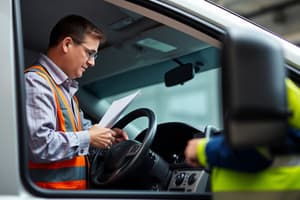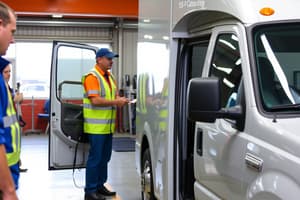Podcast
Questions and Answers
What is the most important reason for doing a vehicle inspection?
What is the most important reason for doing a vehicle inspection?
To ensure the safety of yourself and other drivers.
Name some key steering system parts.
Name some key steering system parts.
Control arm, steering shaft, pitman arm, steering wheel.
What things should you check during a trip?
What things should you check during a trip?
Gauges, mirrors, check vehicle cargo or load when instructed.
Name some suspension system defects.
Name some suspension system defects.
What three kinds of emergency equipment must you have on your vehicle?
What three kinds of emergency equipment must you have on your vehicle?
What is the minimum tread depth for front tires, and other tires?
What is the minimum tread depth for front tires, and other tires?
Name some things you should check on the front of your vehicle during your trip.
Name some things you should check on the front of your vehicle during your trip.
What should wheel bearing seals be checked for?
What should wheel bearing seals be checked for?
How many red reflective triangles should you carry?
How many red reflective triangles should you carry?
How do you test hydraulic brakes for leaks?
How do you test hydraulic brakes for leaks?
Why put the starter switch key in your pocket during the pre-trip inspection?
Why put the starter switch key in your pocket during the pre-trip inspection?
Why should you back toward the driver's side?
Why should you back toward the driver's side?
If stopped on a hill, how can you start moving without rolling back?
If stopped on a hill, how can you start moving without rolling back?
Why is it important to use a helper when backing up?
Why is it important to use a helper when backing up?
What's the most important hand signal to agree on when backing up?
What's the most important hand signal to agree on when backing up?
What are the 2 special conditions where you should downshift?
What are the 2 special conditions where you should downshift?
When should you downshift automatic transmissions?
When should you downshift automatic transmissions?
Retarders keep you from skidding when the road is slippery?
Retarders keep you from skidding when the road is slippery?
What are the 2 ways to know when to shift?
What are the 2 ways to know when to shift?
How far ahead does the manual say you should look?
How far ahead does the manual say you should look?
What are 2 main things to look for ahead of you?
What are 2 main things to look for ahead of you?
What's your most important way to see the sides and rear of your vehicle?
What's your most important way to see the sides and rear of your vehicle?
What does communicating mean in safe driving?
What does communicating mean in safe driving?
Where should your reflectors be placed when stopped on a divided highway?
Where should your reflectors be placed when stopped on a divided highway?
What 3 things add up to total stopping distance?
What 3 things add up to total stopping distance?
If you go twice as fast, will your stopping distance increase by 2 or 4 times as much?
If you go twice as fast, will your stopping distance increase by 2 or 4 times as much?
Empty trucks have the best braking.
Empty trucks have the best braking.
What is hydroplaning?
What is hydroplaning?
What is black ice?
What is black ice?
How do you find out how many seconds of following distance you have?
How do you find out how many seconds of following distance you have?
Study Notes
Vehicle Inspection
- Crucial for ensuring personal safety and safety of others on the road.
- Regular checks include gauges, mirrors, and cargo/load stability during trips.
Steering System
- Key components include control arm, steering shaft, pitman arm, and steering wheel.
Suspension System
- Common defects to watch for: broken or cracked leaf springs, broken hangers, and leaking hydraulic fluids.
Emergency Equipment
- Required items: spare electrical fuses, three red reflective triangles, and properly charged fire extinguishers.
Tire Maintenance
- Minimum tread depth requirements: front tires at 4/32 inches and other tires at 2/32 inches.
Front Vehicle Checks
- Inspect front axle condition, steering system, windshield, and lights/reflectors during trips.
Wheel Bearings
- Ensure cleanliness of wheel bearing seals, free from dirt and debris.
Reflective Triangles
- Must carry three red reflective triangles for safety.
Hydraulic Brakes Testing
- Conduct tests by pressing brake three times and holding for five seconds to check for leaks.
Safety Precautions
- Keep starter switch key in pocket during inspections to prevent unintended vehicle movement.
- Back toward driver’s side for better visibility with mirrors.
Hill Start Techniques
- To prevent rollback, engage the clutch partially before releasing the brake and use a parking brake if necessary.
Blind Spots
- Always utilize a helper when backing up to navigate blind spots safely.
Backing Up Signals
- Establish critical hand signals in advance, with "STOP" being the most important.
Downshifting Conditions
- Necessary to downshift before descending hills or entering curves.
Transmission Shifting
- Downshift in automatic transmissions as indicated above regarding special conditions.
Retarders
- Incorrectly thought to prevent skidding; they assist in vehicle control on downhill slopes.
Shifting Indicators
- Key indicators for shifting include Engine Speed and Road Speed.
Situational Awareness
- Maintain awareness by looking 12-15 seconds ahead, approximately 1/4 mile or one block in city driving.
Side and Rear Visibility
- Side mirrors are vital for visibility alongside and behind the vehicle.
Safe Driving Communication
- Utilize turn signals to communicate intentions to other drivers.
Reflector Placement
- When stopped on a divided highway, place reflectors at distances of 10, 100, and 200 feet behind the vehicle.
Total Stopping Distance
- Comprised of perception distance, reaction distance, and braking distance.
Speed and Stopping Distance
- Doubling speed increases stopping distance by four times.
Braking Performance
- Empty trucks do not have better braking performance; they are less stable.
Hydroplaning Definition
- Occurs when tires lose traction due to water accumulation on the road.
Black Ice
- A deceptive clear ice layer that can mislead drivers into believing the road is dry.
Following Distance Calculation
- Measure following distance by counting seconds between passing a landmark after another vehicle passes it.
Studying That Suits You
Use AI to generate personalized quizzes and flashcards to suit your learning preferences.
Description
Test your knowledge on vehicle inspection essential for CDL Class A drivers. This quiz covers key components and procedures for ensuring safety on the road. Perfect for studying and preparing for your CDL exam.




